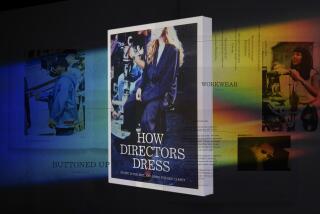Style Trial : Lawyers Enter Fashion Statements as State Takes Nightclub to Court Over Dress Rules
- Share via
You live in L.A. You’ve heard the question:
What are people wearing?
It’s been raised before dining, before barhopping, before clubbing and . . . before an administrative court, where fashion is on trial.
In a hearing room furnished in dingy brown, state liquor authorities charged this week that one of Los Angeles’ trendiest nightclubs, Vertigo, has been discriminating against people because of their clothes.
Accusations in the seemingly superficial dispute have gone deep, raising the question of whether a person’s choice of attire is an inalienable right.
The Alcohol Beverage Control Department charged that government investigators and undercover police officers were denied entry to Vertigo in 1989 because of what doormen deemed a “lack of fashion sense.”
The department investigated the club after numerous prospective patrons complained of having to line up outside while others entered with little more than an assertive fashion statement to recommend them, said ABC attorney David Wainstein.
Vertigo owner Jim Colachis said the discrimination charges are misdirected. If the club is forced to accept patrons on a first-come, first-served basis, the business would soon fold, Colachis said. The precedent set in the case would also lead to restrictions on the way other nightclubs and restaurants conduct business, he said.
For six years, Vertigo has cultivated its image as a bastion of trendiness, becoming a place where the “customers themselves are the decoration,” Colachis said.
In Los Angeles, where 90% of nightclubs close during their first year, Vertigo’s staying power has been its ability to market the intangible cachet of style said Joshua Kaplan, the club’s attorney.
By directing some customers to wait outside--particularly those whose look may detract from the fashionable milieu--the club has sought to reinforce its exclusive image, which owners say has increased the number of patrons willing to pay the $15 entrance fee.
“The marketing principle is simple: You want what you can’t have,” Colachis said.
ABC officials acknowledged that giving priority to people on the basis of fashion is lawful. But, they say, when a dress code is undefined as in the case with Vertigo, the ambiguity can lead to discrimination based on other factors such as race, religion or gender.
“With nebulous entrance criteria like ‘fashionable and stylish dress’ there’s too much room for abuse,” Wainstein said. “The club is a publicly licensed establishment. Everyone should have equal access.”
A society columnist for L.A. Style magazine and a model turned fashion consultant, called to the stand by Vertigo’s attorney, testified on the impracticality of establishing a dress code.
“Fashion is very fluid,” said Yvette Crosby, former fashion director of the California Mart, a downtown building that houses showrooms for hundreds of apparel manufacturers. “It changes week to week, city to city, club to club. . . . By the time you could publish a textbook on what is fashionable, the information would be outdated.”
To illustrate fashion’s capricious nature, a newspaper article on the resurgence of the ‘70s disco fashion was displayed by Vertigo’s attorney.
Owner Colachis said even though the look has recently come back into style, people who appear at Vertigo dressed in polyester leisure suits and platform shoes should plan on a spell in the waiting line outside.
“Fashion is a very subjective thing,” he said.
As Colachis left the courtroom after testifying Monday, a friend asked him: “Hey Jimmy, would they let you into your own club dressed like that?”
He looked down at his chartreuse ETC blazer, mustard and Kelly green Hugo Boss tie and earth tone Armani slacks. “Ha!” he replied.
Administrative Judge Milford A. Maron is scheduled to decide the case within 60 days.
More to Read
Sign up for Essential California
The most important California stories and recommendations in your inbox every morning.
You may occasionally receive promotional content from the Los Angeles Times.










